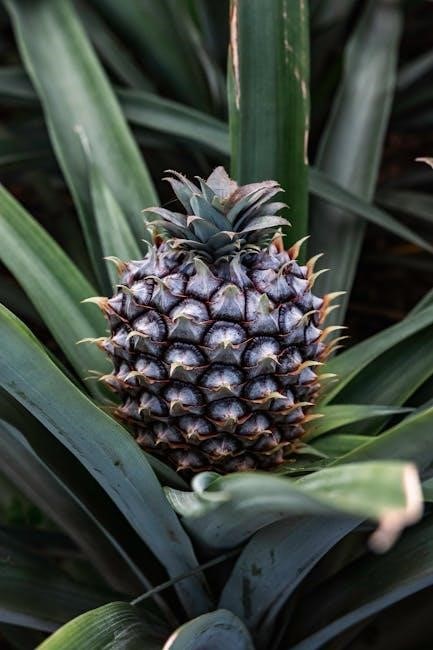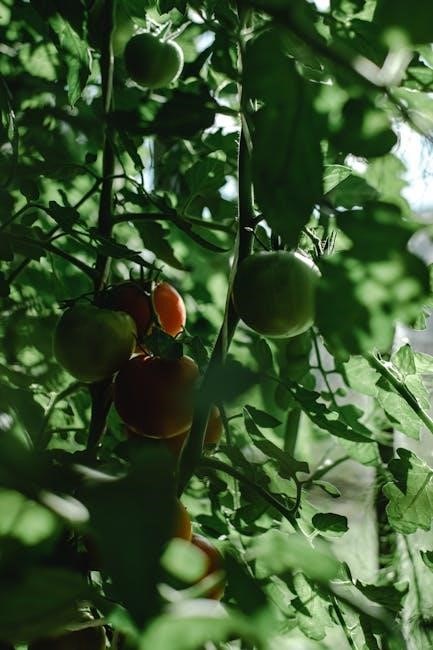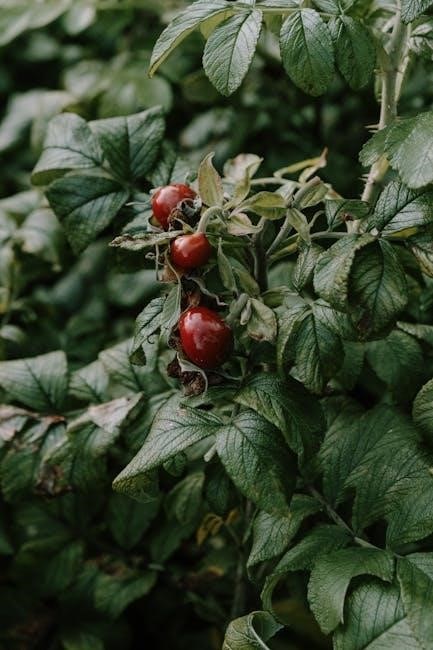Welcome to the Miami Fruit Ripening Guide, your ultimate resource for mastering the art of ripening tropical fruits. Discover expert tips, storage secrets, and ripeness cues to enjoy Miami’s freshest, most flavorful produce year-round.
1.1 Overview of Tropical Fruit Ripening in Miami
Miami’s subtropical climate creates an ideal environment for ripening a variety of tropical fruits. Fruits like mangoes, pineapples, sapodilla, and mamey sapote thrive in the region’s warm, humid weather. The city’s unique conditions allow for year-round fruit cultivation, with ripening processes influenced by Miami’s distinct seasonal patterns; Understanding these local factors is key to maximizing flavor and quality when ripening tropical fruits in this vibrant agricultural hub.
1.2 Importance of Proper Fruit Ripening Techniques
Proper fruit ripening techniques are essential for bringing out the full flavor, texture, and nutritional value of tropical fruits. Improper methods can lead to overripe, spoiled, or underdeveloped fruit, reducing quality and shelf life. By mastering ripening techniques, you ensure optimal freshness, minimize waste, and enhance culinary experiences. This guide provides expert advice tailored to Miami’s climate, helping you achieve perfectly ripened fruits every time and make the most of the region’s abundant tropical bounty.
Understanding the Basics of Fruit Ripening
Fruit ripening involves biological processes like color change, texture softening, and flavor development. Ethylene production and environmental factors like temperature and humidity play key roles in this process.
2.1 How Fruits Ripen: Biological Processes
Fruit ripening is driven by complex biological processes. Ethylene production triggers a series of changes, including starch conversion to sugar, cell wall softening, and chlorophyll breakdown, enhancing color and flavor. Enzymes play a crucial role in breaking down cell components, while acids contribute to taste development. Environmental factors like temperature and humidity influence these processes, ensuring fruits reach optimal ripeness and flavor.
2.2 Factors Affecting Fruit Ripening in Miami’s Climate
Miami’s subtropical climate influences fruit ripening through high temperatures, humidity, and seasonal rainfall. Warm weather accelerates ripening, while excessive heat can cause over-ripening. Humidity aids in maintaining moisture but may lead to spoilage if not managed. Rainfall can enhance fruit size and sweetness but may also cause premature ripening. Understanding these factors helps in optimizing storage and care for tropical fruits.
Popular Tropical Fruits in Miami and Their Ripening Patterns
Miami boasts a variety of tropical fruits like mangoes, pineapples, sapodilla, and mamey sapote, each with unique ripening patterns shaped by the city’s warm, humid climate.
3.1 Mangoes: Ripening Tips and Tricks
Mangoes are a tropical treasure in Miami, with ripening dependent on variety and climate. Store unripe mangoes at room temperature, away from direct sun. To speed ripening, place them in a paper bag with bananas or apples, as ethylene production accelerates the process. Once ripe, mangoes can be refrigerated to prolong freshness. Check for softness around the stem and a sweet aroma to determine ripeness. For optimal flavor, let mangoes ripen naturally before refrigeration.
3.2 Pineapples: Identifying Ripeness and Storage
Pineapples are ready to eat when their skin turns golden yellow, and the flesh is firm yet slightly soft. A sweet aroma and vibrant color signal ripeness. Store unripe pineapples at room temperature, turning occasionally, until ripe. Once ripe, refrigerate whole pineapples for up to a week or cut pieces in an airtight container for 3–5 days. Avoid overripe fruit, as it becomes mushy and loses flavor. Proper storage ensures pineapple stays fresh and delicious for extended enjoyment.
3.3 Sapodilla and Mamey Sapote: Unique Ripening Characteristics
Sapodilla ripens slowly, developing a caramel-like flavor when fully ripe. Store at room temperature until soft to the touch, then refrigerate to halt ripening. Mamey sapote ripens similarly, with a sweet, nutty taste emerging as it softens. Both fruits thrive in Miami’s climate due to warm temperatures. To accelerate ripening, place them in a paper bag with bananas. Once ripe, enjoy their unique flavors, or refrigerate to maintain freshness for several days. Proper handling ensures optimal taste and texture for these tropical gems.

Identifying Ripeness Cues for Tropical Fruits
Recognize ripe tropical fruits by their vibrant color, soft texture, and sweet aroma. Consistency and scent vary by fruit, ensuring timely harvesting for optimal flavor and texture in Miami’s climate.
4.1 Visual Indicators: Color and Appearance
Color and appearance are key visual cues for determining ripeness in tropical fruits. Mangoes, for instance, transition from green to yellow or red as they ripen, while pineapples develop a golden hue. Sapodilla fruits turn from green to brown and become slightly soft. Mamey sapote shifts from green to brown, with a wrinkled skin indicating readiness. Visual changes vary by fruit type, but consistent signs include vibrant colors, slight softening, and wrinkling. These cues help ensure optimal flavor and texture when enjoying Miami’s tropical bounty.
4.2 Tactile and Olfactory Cues: Touch and Smell
Ripeness can also be determined by touch and scent. Tropical fruits like mangoes and pineapples soften slightly as they ripen, while remaining firm to the touch. A sweet, tropical aroma often signals readiness, as seen in ripe mangoes and pineapples. Overly strong odors may indicate overripeness. For fruits like sapodilla and mamey sapote, a gentle squeeze will reveal slight yielding without mushiness. These sensory cues, combined with visual signs, ensure precise ripeness detection for optimal flavor and texture.

Accelerating the Ripening Process
Ethylene-producing fruits like bananas can accelerate ripening. Store fruits in paper bags or alongside bananas to harness natural ethylene for faster ripeness.
5.1 Using Ethylene-Producing Fruits to Speed Up Ripening
Place unripe fruits like mangoes or avocados near ethylene-producing fruits such as bananas or apples. This natural process enhances ripening. Store them in a paper bag to trap ethylene gas, accelerating the ripening process. Check daily to ensure fruits do not overripe. This method is chemical-free and effective for tropical varieties commonly found in Miami.
5.2 Optimal Storage Conditions for Faster Ripening
Store unripe fruits in a cool, well-ventilated area away from direct sunlight. Maintain a consistent temperature between 65-75°F to promote even ripening. Avoid humid environments to prevent mold. For faster results, place fruits in a paper bag with an ethylene-producing fruit. Check daily to monitor progress and ensure optimal ripening without spoilage. Proper storage conditions are key to enjoying Miami’s tropical fruits at their best flavor and texture.

Storing Fruit to Prolong Freshness and Quality
Store ripe fruits separately in breathable containers or paper bags to maintain freshness. Keep unripe fruits at room temperature until ready to eat. Refrigerate ripe fruits to slow spoilage and preserve flavor. Proper storage extends shelf life and ensures Miami’s tropical fruits remain vibrant and delicious for a longer period.
6.1 Refrigeration Techniques for Ripe Fruits
Refrigerate ripe fruits to slow the ripening process and maintain freshness. Store fruits in airtight containers or plastic bags to retain moisture and prevent spoilage. Separate delicate fruits like mangoes and pineapples from strong-smelling foods to avoid flavor transfer. Most tropical fruits, once ripe, can be refrigerated for 3–7 days. Check specific fruit guidelines, as some, like bananas, may darken in color but remain edible when chilled. Proper refrigeration ensures tropical fruits stay vibrant and flavorful for a longer period.
6.2 Best Practices for Storing Unripe Fruits
Store unripe fruits in a cool, dry place away from direct sunlight to slow ripening. Use breathable containers or paper bags to maintain airflow and prevent moisture buildup. Keep ethylene-producing fruits like bananas and apples separate from others to control ripening pace. Regularly check fruits for ripeness to avoid overripening. Once fruits begin to ripen, transfer them to the refrigerator to extend freshness. Proper storage ensures optimal flavor and texture when fruits are ready to eat.
Common Challenges and Troubleshooting
Identify common issues like overripe fruits or slow ripening. Learn practical solutions to extend shelf life and optimize ripening processes effectively.
7.1 Dealing with Overripe or Spoiled Fruits
Overripe or spoiled fruits can be a common challenge. To manage this, inspect fruits regularly for signs of spoilage, such as mold, soft spots, or unpleasant odors. Separate healthy fruits from spoiled ones to prevent further decay. For overripe fruits, consider using them in jams, smoothies, or baked goods to minimize waste. Additionally, proper storage techniques, like refrigeration, can help extend the shelf life of ripe fruits and prevent spoilage.
7.2 Solving Issues Related to Slow Ripening
Slow ripening can be addressed by adjusting storage conditions. Place fruits in a warm, well-ventilated area to encourage ripening. For certain varieties, storing them with ethylene-producing fruits like bananas or apples can stimulate ripening. Avoid refrigeration until fruits are fully ripe, as cold temperatures can halt the ripening process. Monitor fruits daily and adjust their environment as needed to ensure they reach optimal ripeness and flavor.
Mastering fruit ripening enhances flavor and texture. Store fruits properly, use ethylene-producing companions, and monitor ripeness. Explore Miami’s tropical diversity and enjoy nature’s sweetest rewards!
8.1 Summary of Key Ripening Strategies
To ensure optimal fruit ripening, store unripe fruits at room temperature and ripe ones in the refrigerator. Use ethylene-producing fruits like bananas to accelerate ripening. Monitor color, texture, and aroma for ripeness cues. For tropical varieties, follow specific guidelines, such as allowing mangoes to soften at room temperature and pineapples to develop a sweet fragrance. Proper storage and handling will prolong freshness and flavor, ensuring a delightful tropical experience in Miami.
8.2 Encouragement to Explore Miami’s Tropical Fruit Diversity
Miami’s vibrant climate nurtures a stunning array of tropical fruits, each with unique flavors and textures. From juicy mangoes to aromatic pineapples, and lesser-known gems like sapodilla and mamey sapote, the diversity is endless. Embrace the opportunity to explore these treasures by mastering ripening techniques. Experiment with new varieties, savor their richness, and discover why Miami is a paradise for fruit enthusiasts. Let this guide inspire your culinary adventures and deepen your appreciation for tropical delights.



0 Comments